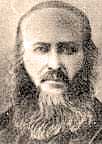 Churches of Christ & Christian Churches in the Pacific Northwest COASTAL TOWNS |
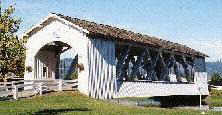 Expanded June 12, 2008 by Charles Dailey College index |
Astoria | Bridge | Coos Bay | Coquille | Fairview | Harbor | Myrtle Point
North Bend | Oretown | Pioneer | Riverton | Tillamook | WaldportPhoto page: Central Avenue, Coos Bay
Next Chapter . . . Pioneer Menu . . . Search - - - Oldest presented first
Coquille Mapquest map
If the word Coquille is of French origin, it means shell.
This congregations dates from 1871 or before.
A Christian Church reported their presence to the Christian Messenger in 1871 and they numbered 20 by that time.
Thomas McBride Morgan wrote in the Christian Messenger that "Bro. Smith and Bro. Todd" had been preaching in Coquille in 1877. These men were John Burris Smith and Abbot Levi Todd, both from Douglas County.
A "one liner" in the Pacific Christian Messenger say there was a plan to "organize" the church on the 3rd Sunday of June, 1878. Those organizing would be T. M. Morgan, J. B. Smith and "Bro. Hayes of Coquille."
T. M. Morgan may have lived in the Fairview community. At least he wrote from there in 1877. That same year, he wrote to the Pacific Christian Messenger about their financial needs. The letter reads,
Coquille City is in the center of Coos County, and we desire it to be a neuclus (sic) from which a glorious work will spread a happy influence all over this valley. . . .
Yours in hope,
Mr. Morgan wrote to the Pacific Christian Messenger in 1880 that he had been at Coquille four years. That places the beginning of his work in 1876. He preached one time each month, speaking other places in the area on the other Sundays. One of the other places must have been Drain, in Douglas County.
The group may have reorganized because in 1888, C. A. (or C. H.) Alley began holding services. They met in the Universalists building on Adams Street.
By 1889 farmer Steven B. Hollenbeak was doing the preaching. On October 1, 1890, the church was incorporated as the Christian Church Association of Coquille City, Coos County, Oregon. Trustees were J.J. Wilson, W.E. Post and Elisabeth Fouts.
In 1891 property was purchased and soon a 36' x 45' building was erected on E. 4th Street at N. Dean. This artist's drawing of the original building under construction reveals several things. (We have found the drawings to be accurate with other buildings.) The original building had four windows on a side and a bell tower in front.
In 1910, the building was enlarged to include a kitchen, fellowship hall, classrooms and a baptistry. The building as it is now was added to in the front and the bell tower removed. It was also added to in back and a full basement was added. We know that it is the same building in both pictures because the dates match.
The building was dedicated in 1892 by C. R. Comb, an evangelist visiting from California.
An informative article appeared in the Christian Standard of 1893:
There is a profile of T. M. Morgan. Also a profile of J. B. Smith and A. L. Todd.
That same year, Aurelius, A. L. Todd's son, found that Maggie Fouts was just his type and they were married at the Coquille School House. (We can imagine that Aurelius had been anxious for dad to cross the mountains and preach in Coquille.)
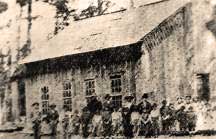
Creek where the church met.
The door is on the far right.
Coquille City, Or.
August 7, 1877
To the congregations in the older, settled districts:
Dear Brethren in the Lord. In your kindness will you please indulge me a little as I extend to you a call on behalf of Coquille City church. We have a membership of some 50, all told. Mostly female members and are nearly all poor in the goods of this world, but I trust, so at least, are rich in faith and hope. We are confined to an uncomfortable school house, and are often shut out of it when we have an important meeting on hand. . . .
T. M. Morgan
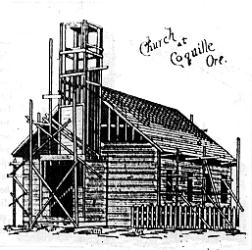
Source: Christian Standard, 1892
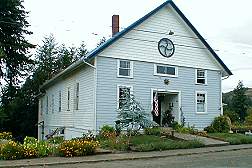
260 E. 4th Street.
Workmen left an 1893 date in
the original portion, and an 1894
date in the portion added at the front.
Coquille City, May 25 - Evangelist N. B. Alley commenced a meeting at this place on April 18, and closed May 22, with 26 additions -- sixteen by baptism, and ten otherwise. It was a grand, good meeting, and will result in lasting good to this church. . . . He assisted us to seat our new house. It is not finished, but, we can worship in it. We now have a membership of 43. Bro. Alley has a warm place in our hearts. -- B. F. Hill
The building is now a private residence. The gracious owner allowed us to look at the inside of the structure.
The church has moved to another location and is still very active in the community.
Fairview Mapquest map
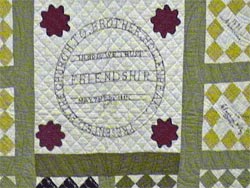
|
Quilt given to Steven Hollenbeak by the church in 1891. The signers are listed in the box below. Courtesy of Coos County Historical Museum. |
Farmer Steven B. Hollenbeak and his wife Amanda, seven years younger, had migrated to Fairview from the family enclave at Fort Crook, California. It was located on Highway 299 near Fall River Mills. They had at least seven children: Effie, Orlando, Mary, Georgia, James, Nancy and Gracie.
In the 1880 issue of the Christian Standard, published in Ohio, a note by Steven Hollenbeak reported the following:
Fairview, Coos County, Oct. 6 -- I have been here fourteen months. Have been preaching as often as circumstances would permit. On the 4th of July we organized with 7 members; since we have received 3 (?) by confession and baptism, and 10 from other sources - some by relation, some by letter, and some from other churches - so we now number 20. And the church is at peace, and the spirit of the Master prevails. . . .Hollenbeak also wrote, "All my labors have been voluntary. Many times I have walked to my appointment ten miles through the muddiest roads I ever saw."
Nine years later, Mr. Hollenbeak was still working in spite of the mud. He reported in 1889 that there had been four additions and that he was preparing for a gospel meeting in September. In 1891 the church prepared a Friendship Quilt with members signing their names. Those listed on blocks were:
|
Meyette Bond (or Boil),
Mrs. Rosy Barger,
Clarence and Ray Dean,
D. F. Dean,
Mrs. D. F. Dean,
Leona Dean,
Lillian Dean,
Maggie H. Dean,
Mary E. Dean,
Provit E. Dean,
Walter Dean,
Elisabeth Fouts,
Jake Fouts,
Violet J. Foy,
Mattie Goodman,
Flo Graham,
Frank Graham,
Laura Graham,
Mrs. Mary Kelly,
A. E. Martin,
Mrs. Ella Martin,
J. E. Martin Jr.,
Mabel Martin,
Ora Maury,
W. E. McDuffee,
Jane Petit,
Jeff Pettit,
Nelson Petit,
Mrs. Arlo Schuers,
George Schuers,
Harvey Schuers ,
Josie Schuers,
A. Seed,
V. A. Seed,
B. L. Seed,
L. A. Seed,
Jennie Simmons,
Johnie Simmons,
Phoeby Simmons,
Mrs. J. L. Smith,
Annie Smith,
Thomas Smith,
Lydia Simmons,
Scotty Stock,
E. M. Strong (or Streng),
Mrs. Eliza Taft,
Ida Voss,
Flora Wilson,
Jerry J. Wilson,
Rolla Wilson,
Rosa Wilson,
Rosa L. Wilson and
Sila Wilson.
|
Record has not been left of where the church met. It could have been the school house, the community hall or they might have even crowded into a private home. The living memory of the community is that the one church building in town was built after this era.
The town declined, the members of the Church of Christ moved away and eventually the church meetings ceased. Steven and Amanda Hollenbeak are buried in the Fairview Cemetery.
Bridge Mapquest

|
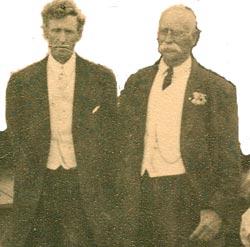 |
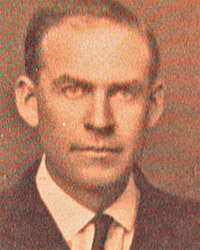 |
In its earliest days, Bridge was a stage stop between Camas Valley and Myrtle Point. Often horses were changed here. Amos and Annie Nostler moved here in 1900 and began a church in the upper floor of their home. It was a place of community meetings. They had a store and postoffice across the street from their home. Their son Claud and his wife were both musical. Claud was the first Sunday School Superintendent.
J. M. Connell of Roseburg held a night-to-night meeting in 1908 in Nostler Hall. Shortly after this, David E. Norcross, a student from Northwest Christian College, held meetings and several were baptized into Christ.
Other early members included Amsey and Zua Hooten, Mr. and Mrs. Hill (Zua parents) and the Roselles. The building pictured was built on Nostler property about 1912. The drawing understates the size of the building. The first preacher was Doctor Jacob P. Easter (formerly of Roseburg), followed by Turner B. McDonald.
|
Members in 1912 included: Mina Allen, Dwight Culver, Frank Culver, Grandma Culver, Jim Culver, Dr. Jacob P. Easter, Dorcia Endicott, Merle Endicott, Ray Endicott, Ella Endicott, Mrs. Endicott, Mrs. A. Everndon, Alice Everndon, Hanz Everndon, Horrace Everndon, Amsey Hooton, Edna Hooton, Lou Hooton, Maude Hooton, Zua Hooton, Annie Lett, Flossie Lett, Orlin Lett, Will Lett, Wilma Lett, Mrs. (Maud) McDonald, Turner B. McDonald, Dorothy Moon, Emily Musick, Bryce Nostler, Mr. Price, Edna Price, Margaret Roselle, Mrs. Roselle, Neoma Roselle, Ora Roselle, Pearl Roselle and G. E. Williams. |
Other widely known names connected with the Bridge Church included Lawrence Sunkler, Gottlieb Schmid and Charles Ennis Mulkey who later became the Coos County Superintendent of Schools.
Coos Bay Mapquest
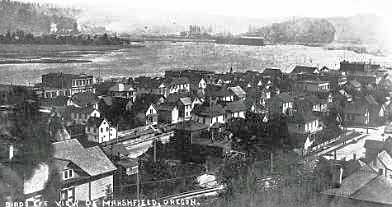
|
See the photo of corduroy the road going up Central Avenue, 1912.
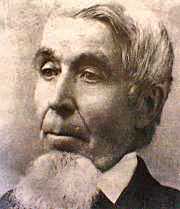
|
Neil Monroe came to Coos Bay because his family had long been identified with the production of coal in his native Renfrew County in Scotland. He came west by way of Kentucky, where he lived for a time. Because he left Kentucky at the time of the Civil War, he may have arrived in the area in the 1860s.Monroe had studied for the ministry at an early point in life. While involved in coal mining at Coos Bay, he also preached on Sundays and gathered quite a following. They were baptized in Coal Bank Slough. One writer described Monroe as a quiet, serious man who was deeply religious.
Historian Dow Beckham says, "There is no record of any sect or congregational connections with Monroe other than the converts became Christians."
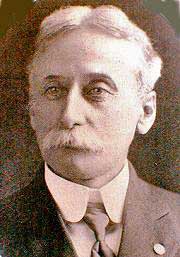
|
Dow Beckham in Stars in the Dark. Arago Books, 1995.After Monroe's death in 1902, his disciples cannot be positively traced. However Charles Augustus Sehlbrede arrived to provide leadership for establishing a Church of Christ and to make "Christians only." He had come overland from Indiana in 1877, was admitted to the Oregon Bar in 1878 and served in the Oregon House of Representatives until President McKinley appointed him as U.S. Commissioner at Skagway, Alaska. Following his stint in Alaska, he returned to Oregon.Wherever Sehlbrede (1852-1922) settled, it seems that he established a church of the New Testament order. He located 30 people that wanted to form a church and they launched the new congregation in 1907. After difficulty in renting a meeting place, the Sehlbrede's offered their home for church. They had also done this while living in Roseburg some years earlier. Sehlbrede's influence can be noted in the careful legal documentation of its earliest years.
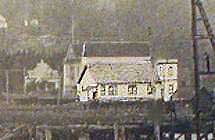 |
There is a separate profile of C. A. Sehlbrede.Very soon the church built on W. Central Avenue, between 6th S. and 7th S., next to the Myrtle Arms Apartments (seen in the background). The Myrtle Arms Apartment Building, built in 1914, is on the National Register of Historic Places for Coos County. It is an example of Mission and Pueblo styles of architecture.
That church building with its 24 foot bell tower was later moved and finally replaced by a larger one. We have a large photo of the second building on this link.
Riverton Mapquest map
Dr.Clarence Swander lists the Riverton Church in Coos County as beginning in 1901. There is no living memory of it in the community and no record in nearby libraries or museums. We found an unsubstantiated story in Riverton that a church building had been dismantled long ago. We are left to speculate.
The first coal mine opened in the county about 1854. Mining was the most important industry at one time and up to one-fourth of the population may have worked in it. Riverton was a coal mining center for more than 50 years. The largest development came in the years following the opening of the Timon Mine in 1895. It may be that either the coal miners or those who came to provide business services for the miners set up a Christian Church and as the town declined, the church members moved away. There are no stores in Riverton today. The local Community Church does not have its roots in the Churches of Christ or Christian Churches.
Myrtle Point Mapquest map
The 100 year anniversary book of the First Christian Church in Myrtle Point reports that the congregation met November 24, 1902 to begin a church. They were able to build by 1905.
However, A. L. Todd worked during 1862 to establish a congregation there. With forty years between those dates, the earlier work of Todd could have died out, or just a tiny fragment of Todd's disciples survived the 40 years and were part of the new group.
The church built on the southeast corner of Willow and 6th. It was a one story building heated with stoves and lighted with gas lamps. The building had a combination bell tower and entry way at the intersection.The first minister was a "Reverend Wood." There is a possibility that it was church planter Galen Wood. Mr. Wood had used the title reverend while living in Montana. He and his wife Agnes (or Aggie) were living in Seattle in 1910. Another possibility is that preacher W. A. Wood of Roseburg was the man. The Disciples Year Book shows him living at Roseburg in 1900.
North Bend Mapquest mapCircuit-riding Abbott Levi Todd, based near Roseburg, recorded preaching in North Bend in 1862. If a congregation was established, it later dispursed like so many others in this pioneer era. Members moved away looking for better employment.
Official Disciples historian Clarence Swander records the beginning as 1914 under the leadership of church planter Samuel Gregg. It can also be established that D. Loyd Morgan was resident there in 1918-1919.
By 1920, the fire map shows the Christian Church at 763 Vermont Street.Waldport Mapquest
The descriptive name Waldport means forest in German and port, with reference to Alsea Bay.
Orlena
RubleDavid
RubleCourtesy of Joanna E. Long One record reports that overland pioneer and town founder David Ruble donated a lot for a church with the stipulation that it be non-sectarian. David's older brother William later started the Church at Golden in Josephine County.
The building foundation came from redwood logs off the beach, the lumber and logs from rafts floated down river. Little is known about the development of this congregation.
Both David Ruble and his wife Orlena are buried in the Alder Grove Cemetery, off Eckman Creek Road east of Waldport.
Oretown Mapquest
C. F. Swander, writing in 1928, noted that a Church of Christ first reported from here in 1883, but he did not know where Oretown was located. The name is from "Oregon town." Oretown Road can still be found .8 mile north of the intersection of U.S. 101 with the road that turns to Wi-Ne-Ma Christian Camp. The old town cemetery is just .3 miles east of Highway 101 on Oretown Road.
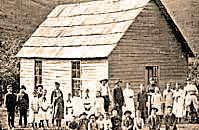
1st Oretown School
Wi-Ne-Ma Christian Camp maintains an informative web presence.A leading family from the Sheridan, Oregon church lived here for the 14 years beginning in 1876. They were Marcellus and Caroline Faulconer. Usually when pioneer Christians moved to a locale where there was no congregation of the Churches of Christ or Christian Churches, one came into existence immediately. Oretown was just another example. If they met in the school house (pictured), then this is where they met. Since they operated a store, they may have met there. This family had been instrumental in establishing the Sheridan Church in Yamhill County before they moved here.
The Sheridan Christian Church is listed on our Yamhill County site.Preacher Jerome B. Franklin arrived from Missouri in 1882 and held services in the school house. He is said to have "preached from his Bible, without notes and his song book was printed in the old style using dots, dashes, commas and numbers."
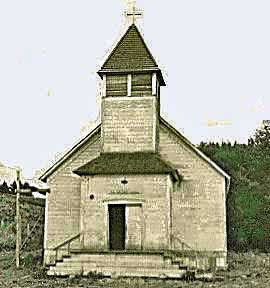
Church at Oretown
as it appeared in 1933.
Copyright 2001 by Iron Trolley Connections.
Used with permission.Regular church assemblies may have been discontinued for a while because one unpublished history reports that circuit-riding Keathley Bailes moved to Oretown in 1898 and began services in the school house in 1899.
There is a profile of Keathley Bailes.Evidently a church building was constructed around the turn of the century. It has had two formal names throughout its years: Oretown Gospel Church and more recently, Oretown Bible Church. Somewhere in the earlier part of the 1900, it was known locally as the Christian Church, but that relationship no longer exists and the local heirs of the Stone-Campbell Movement meet at Winema Christian Camp, right on the coast.
We have this early photo of the Oretown Church building from Linda Kirkham Walton.
Ben Rees in Hong Kong remembers a cheese factory in Oretown when he was a youth. He reports that folks with a Christian Church background had left the Oretown Bible Church to establish the Wi-Ne-Ma Christian Church. This may point to a uniting of the two groups earlier in the century.
Check here for a photo and background for Ben Rees.
Our thanks to Linda Kirkham Walton for her extensive research on the backgrounds of the several church groups in the Oretown area.Tillamook Mapquest
In the years when Tillamook could only be reached reliably by ship, G. L. Smith and John Barker came to build and operate a sawmill. G. L. Smith's father-in-law, H. B. Morgan, came to bring the gospel to this isolated Oregon coast town.
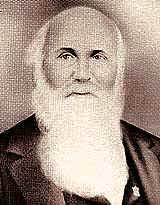
H.B. Morgan H. B. and Ellen held services in their own home, then at the Smith residence. The home meeting began in the Spring of 1889 and by Fall they were conducting public services at the Tillamook Court House.
There were 12 charter members when the Tillamook Christian Church was formally and legally organized in December of that year. By 1891 the church had purchased land and began construction of their first building, pictured below.
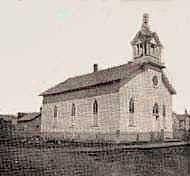
Original Church building During construction a storm destroyed the structure. H. B. Morgan began the next morning to salvage the wreckage. Well-to-do businessmen offered to loan funds for reconstruction and the building was rebuilt as quickly as the weather permitted.
By 1892 the building was ready to occupy using boards for seats. The building was not dedicated until the debt was removed, but God was worshipped and that is the main objective.
According to a local newspaper, E. M. Patterson was the minister in 1904.
The church continues today near the heart of town, its building and parking lots covering nearly a city block.
Astoria Mapquest
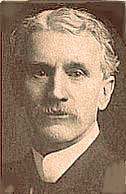
J. N. Smith The Astoria Daily Budget reported in March of 1893 that J.N. Smith divided his time between Third Christian Church of Portland and the Astoria Christian Church. He had not been in town recently because he was holding revival meetings and most recently at Monmouth. The church was meeting in the YMCA building twice each Sunday, but was planning to build soon.
In the year before this news item, Christian Standard carried the following story about Astoria:
There is a good probability of their having a valuable lot given them, and money with which to build a church. . . . We truly hope that Bro. Smith's work will result in establishing a good strong congregation.J. N. Smith had recently come west after living in Helena, Montana.
Swander reports this church died, but on the fourth try in 1918 it survived and grew. Such an example of persistence!
Pioneer Mapquest
Pioneer was indeed a town with a twin. Less than one mile away was Pioneer City. They were situated inland from Newport in Lincoln County and on the Yaquina River. Check the Yahoo map for precise location.
In his Masters Thesis of 1918, Victor Hoven, notes the existence of a Christian Church or Church of Christ in Pioneer with 25 members in 1917, but lists its beginning as 1895. Some of the members may have worked for Pioneer Sandstone Company, at one time a major source of employment in the communities.
Harbor Mapquest
There is a word-of-mouth history of a group that ceased meeting before the Brookings Harbor Church of Christ (later renamed Brookings Harbor Christian Church) was founded. Solid evidence has not been located for a pioneer church in Harbor, but we are hoping that some reader can help. Our readers have been a great resource in compiling this history.
The Curry County Annotated Biographical Index to 1900 in the Chetco Community Public Library shows numerous members of the Mulkey clan living in the area before 1900. As a general rule, where there were Mulkeys, there was a church patterned after the Book of Acts.
There was a shortage of preachers in general in Curry County. An appeal in the Gold Beach Gazette of 1888 reads:
Our church privileges are not the best in the world, and we might here suggest that our Eastern brothers who have a surplus of missionaries to send into heathen lands to be devoured by cannibals would do well to send a few to this coast. We would not eat them, but on the other hand would treat them well, listen to their teachings, and allow them to support themselves.
Next Chapter: Columbia County or back to Pioneer Menu
To DOCHS 2/02


